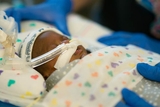
Antibiotic use in neonatal intensive care units (NICUs) decreased substantially over the past decade, according to researchers at Children’s Hospital of Philadelphia (CHOP). The findings, published in a research letter in JAMA Pediatrics, may reflect the success of antibiotic stewardship efforts focused on the use of antibiotics in hospitalized newborns.
To assess the use of antibiotics in the NICU, the researchers analyzed data from nearly 1.4 million infants from 735 NICUs between 2009 and 2021. They found that the proportion of newborns receiving antibiotics decreased by a third, from 54.8% in 2009 to 35.9% in 2021. Overall consumption of antibiotics, measured in days of therapy, dropped by nearly half (48.7%) over the study period.
The most significant reductions were for ampicillin and gentamicin, the two most commonly prescribed antibiotics in NICUs, which each decreased by about a third (35.1% and 32.3%, respectively). Vancomycin use decreased by half, and cefotaxime use declined by almost 20-fold, likely driven by a national shortage and subsequent discontinuation of the drug. Use of ceftazidime, which can be used in place of cefotaxime, increased by 5-fold, likely driven by the cefotaxime shortage. The researchers noted that there were no significant annual changes for cefazolin, cefepime, piperacillin-tazobactam, anti-staphylococcal pencillins, or carbapenems.
“Our research shows that we have made significant progress in reducing antibiotic exposure in the NICU – fewer newborns are started on antibiotics, and treatment durations have shortened,” said first author Dustin D. Flannery, DO, MSCE, an attending neonatologist at CHOP and Assistant Professor of Pediatrics at the University of Pennsylvania. “However, there is still room for improvement in reducing unnecessary use of antibiotics in the NICU. Future studies should include microbiology data to correlate the prevalence of infection with antibiotic use and also further explore antibiotic indications.”
Learn more about CHOP’s antibiotic stewardship research here.
Featured in this article
Specialties & Programs
Antibiotic use in neonatal intensive care units (NICUs) decreased substantially over the past decade, according to researchers at Children’s Hospital of Philadelphia (CHOP). The findings, published in a research letter in JAMA Pediatrics, may reflect the success of antibiotic stewardship efforts focused on the use of antibiotics in hospitalized newborns.
To assess the use of antibiotics in the NICU, the researchers analyzed data from nearly 1.4 million infants from 735 NICUs between 2009 and 2021. They found that the proportion of newborns receiving antibiotics decreased by a third, from 54.8% in 2009 to 35.9% in 2021. Overall consumption of antibiotics, measured in days of therapy, dropped by nearly half (48.7%) over the study period.
The most significant reductions were for ampicillin and gentamicin, the two most commonly prescribed antibiotics in NICUs, which each decreased by about a third (35.1% and 32.3%, respectively). Vancomycin use decreased by half, and cefotaxime use declined by almost 20-fold, likely driven by a national shortage and subsequent discontinuation of the drug. Use of ceftazidime, which can be used in place of cefotaxime, increased by 5-fold, likely driven by the cefotaxime shortage. The researchers noted that there were no significant annual changes for cefazolin, cefepime, piperacillin-tazobactam, anti-staphylococcal pencillins, or carbapenems.
“Our research shows that we have made significant progress in reducing antibiotic exposure in the NICU – fewer newborns are started on antibiotics, and treatment durations have shortened,” said first author Dustin D. Flannery, DO, MSCE, an attending neonatologist at CHOP and Assistant Professor of Pediatrics at the University of Pennsylvania. “However, there is still room for improvement in reducing unnecessary use of antibiotics in the NICU. Future studies should include microbiology data to correlate the prevalence of infection with antibiotic use and also further explore antibiotic indications.”
Learn more about CHOP’s antibiotic stewardship research here.
Contact us
Amanda DiPaolo Bradley
Division of Neonatology